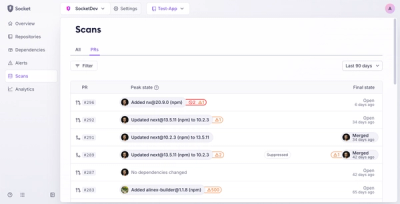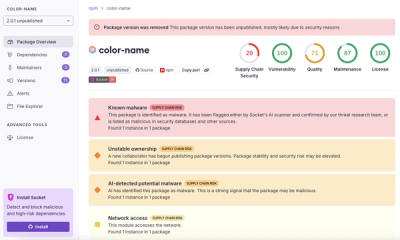
Product
Introducing Pull Request Stories to Help Security Teams Track Supply Chain Risks
Socket’s new Pull Request Stories give security teams clear visibility into dependency risks and outcomes across scanned pull requests.
@tensorflow-models/deeplab
Advanced tools
Semantic Segmentation in the Browser: DeepLab v3 Model
This package contains a standalone implementation of the DeepLab inference pipeline, as well as a demo, for running semantic segmentation using TensorFlow.js.

In the first step of semantic segmentation, an image is fed through a pre-trained model based on MobileNet-v2. Three types of pre-trained weights are available, trained on Pascal, Cityscapes and ADE20K datasets.
To get started, pick the model name from pascal, cityscapes and ade20k, and decide whether you want your model quantized to 1 or 2 bytes (set the quantizationBytes option to 4 if you want to disable quantization). Then, initialize the model as follows:
const tf = require('@tensorflow-models/tfjs');
const deeplab = require('@tensorflow-models/deeplab');
const loadModel = async () => {
const modelName = 'pascal'; // set to your preferred model, either `pascal`, `cityscapes` or `ade20k`
const quantizationBytes = 2; // either 1, 2 or 4
return await deeplab.load({base: modelName, quantizationBytes});
};
const input = tf.zeros([227, 500, 3]);
// ...
loadModel()
.then((model) => model.segment(input))
.then(
({legend}) =>
console.log(`The predicted classes are ${JSON.stringify(legend)}`));
By default, calling load initalizes the PASCAL variant of the model quantized to 2 bytes.
If you would rather load custom weights, you can pass the URL in the config instead:
const deeplab = require('@tensorflow-models/deeplab');
const loadModel = async () => {
const url = 'https://tfhub.dev/tensorflow/tfjs-model/deeplab/pascal/1/default/1/model.json?tfjs-format=file';
return await deeplab.load({modelUrl: url});
};
loadModel().then(() => console.log(`Loaded the model successfully!`));
This will initialize and return the SemanticSegmentation model.
You can set the base attribute in the argument to pascal, cityscapes or ade20k to use the corresponding colormap and labelling scheme. Otherwise, you would have to provide those yourself during segmentation.
If you require more careful control over the initialization and behavior of the model (e.g. you want to use your own labelling scheme and colormap), use the SemanticSegmentation class, passing a pre-loaded GraphModel in the constructor:
const tfconv = require('@tensorflow/tfjs-converter');
const deeplab = require('@tensorflow-models/deeplab');
const loadModel = async () => {
const base = 'pascal'; // set to your preferred model, out of `pascal`,
// `cityscapes` and `ade20k`
const quantizationBytes = 2; // either 1, 2 or 4
// use the getURL utility function to get the URL to the pre-trained weights
const modelUrl = deeplab.getURL(base, quantizationBytes);
const rawModel = await tfconv.loadGraphModel(modelUrl);
const modelName = 'pascal'; // set to your preferred model, out of `pascal`,
// `cityscapes` and `ade20k`
return new deeplab.SemanticSegmentation(rawModel);
};
loadModel().then(() => console.log(`Loaded the model successfully!`));
Use getColormap(base) and getLabels(base) utility function to fetch the default colormap and labelling scheme.
import {getLabels, getColormap} from '@tensorflow-models/deeplab';
const model = 'ade20k';
const colormap = getColormap(model);
const labels = getLabels(model);
The segment method of the SemanticSegmentation object covers most use cases.
Each model recognises a different set of object classes in an image:
model.segment(image, config?) inputsimage :: ImageData | HTMLImageElement | HTMLCanvasElement | HTMLVideoElement | tf.Tensor3D;
The image to segment
config.canvas (optional) :: HTMLCanvasElement
Pass an optional canvas element as canvas to draw the output
config.colormap (optional) :: [number, number, number][]
The array of RGB colors corresponding to labels
config.labels (optional) :: string[]
The array of names corresponding to labels
By default, colormap and labels are set according to the base model attribute passed during initialization.
model.segment(image, config?) outputsThe output is a promise of a DeepLabOutput object, with four attributes:
legend :: { [name: string]: [number, number, number] }
The legend is a dictionary of objects recognized in the image and their colors in RGB format.
height :: number
The height of the returned segmentation map
width :: number
The width of the returned segmentation map
segmentationMap :: Uint8ClampedArray
The colored segmentation map as Uint8ClampedArray which can be fed into ImageData and mapped to a canvas.
model.segment(image, config?) exampleconst classify = async (image) => {
return await model.segment(image);
}
Note: For more granular control, consider predict and toSegmentationImage methods described below.
To segment an arbitrary image and generate a two-dimensional tensor with class labels assigned to each cell of the grid overlayed on the image (with the maximum number of cells on the side fixed to 513), use the predict method of the SemanticSegmentation object.
model.predict(image) inputimage :: ImageData | HTMLImageElement | HTMLCanvasElement | HTMLVideoElement | tf.Tensor3D;
The image to segment
model.predict(image) outputrawSegmentationMap :: tf.Tensor2D
The segmentation map of the image
model.predict(image) exampleconst getSemanticSegmentationMap = (image) => {
return model.predict(image)
}
To transform the segmentation map into a coloured image, use the toSegmentationImage method.
toSegmentationImage(colormap, labels, segmentationMap, canvas?) inputscolormap :: [number, number, number][]
The array of RGB colors corresponding to labels
labels :: string[]
The array of names corresponding to labels
segmentationMap :: tf.Tensor2D
The segmentation map of the image
canvas (optional) :: HTMLCanvasElement
Pass an optional canvas element as canvas to draw the output
toSegmentationImage(colormap, labels, segmentationMap, canvas?) outputsA promise resolving to the SegmentationData object that contains two attributes:
legend :: { [name: string]: [number, number, number] }
The legend is a dictionary of objects recognized in the image and their colors.
segmentationMap :: Uint8ClampedArray
The colored segmentation map as Uint8ClampedArray which can be fed into ImageData and mapped to a canvas.
toSegmentationImage(colormap, labels, segmentationMap, canvas?) exampleconst base = 'pascal';
const translateSegmentationMap = async (segmentationMap) => {
return await toSegmentationImage(
getColormap(base), getLabels(base), segmentationMap)
}
Please see the demo documentation.
This model is based on the TensorFlow implementation of DeepLab v3. You might want to inspect the conversion script, or download original pre-trained weights here. To convert the weights locally, run the script as follows, replacing dist with the target directory:
./scripts/convert_deeplab.sh --target_dir ./scripts/dist
Run the usage helper to learn more about the options:
./scripts/convert_deeplab.sh -h
FAQs
Semantic Segmentation in the Browser: DeepLab v3 Model
We found that @tensorflow-models/deeplab demonstrated a not healthy version release cadence and project activity because the last version was released a year ago. It has 9 open source maintainers collaborating on the project.
Did you know?

Socket for GitHub automatically highlights issues in each pull request and monitors the health of all your open source dependencies. Discover the contents of your packages and block harmful activity before you install or update your dependencies.

Product
Socket’s new Pull Request Stories give security teams clear visibility into dependency risks and outcomes across scanned pull requests.

Research
/Security News
npm author Qix’s account was compromised, with malicious versions of popular packages like chalk-template, color-convert, and strip-ansi published.

Research
Four npm packages disguised as cryptographic tools steal developer credentials and send them to attacker-controlled Telegram infrastructure.